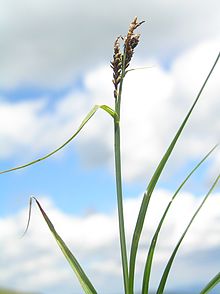Carex bigelowii
| Carex bigelowii | |
|---|---|

| |
| Scientific classification | |
| Kingdom: | Plantae |
| Clade: | Tracheophytes |
| Clade: | Angiosperms |
| Clade: | Monocots |
| Clade: | Commelinids |
| Order: | Poales |
| Family: | Cyperaceae |
| Genus: | Carex |
| Species: | C. bigelowii
|
| Binomial name | |
| Carex bigelowii | |
| Synonyms | |
| |
Carex bigelowii is a species of sedge known by the common names Bigelow's sedge,[2] Gwanmo sedge,[3] and stiff sedge.[4] It has an Arctic–alpine distribution in Eurasia and North America, and grows up to 50 centimetres (20 in) tall in a variety of habitats.
Distribution
Carex bigelowii has a circumpolar
Description
Carex bigelowii produces 3-angled stems up to 50 centimetres (1.6 ft) tall, growing in a tuft or singly. The leaves are stiff and dark green, and the leaves of previous seasons may remain on the plant. The inflorescence is accompanied by a short bract. The inflorescence has 1–3 black pistillate spikes under 1–2 staminate spikes.[5] The plant usually reproduces vegetatively, sprouting tillers from its rhizome. It also spreads via stolons.[6] It has a thick root network that allows it to form a turf, and the roots may grow 80 cm (2.6 ft) deep in the soil.[9] The plant sometimes reproduces sexually, producing seeds, which can remain viable for 200 years.[6]
Ecology
Carex bigelowii grows in many types of Arctic and alpine habitat. It occurs in forest,
Carex bigelowii can colonize disturbed habitat. It has been noted to grow at oil spill sites within two months of the disturbance, and it grows alongside the Dempster Highway in northwestern Canada. Its long-lasting soil seed bank allows it to sprout after the soil is disturbed, and the rhizomes may prevent erosion.[6]
References
- ^ = Carex+bigelowii "Carex bigelowii - Torr. ex Schwein". NatureServe Explorer. NatureServe. July 2012. Retrieved December 15, 2012.
{{cite web}}: Check|url=value (help) - ^ USDA, NRCS (n.d.). "Carex bigelowii". The PLANTS Database (plants.usda.gov). Greensboro, North Carolina: National Plant Data Team. Retrieved 10 January 2016.
- .
- ^ BSBI List 2007 (xls). Botanical Society of Britain and Ireland. Archived from the original (xls) on 2015-06-26. Retrieved 2014-10-17.
- ^ ISBN 9780195152074.
- ^ USDA Forest Service, Rocky Mountain Research Station, Fire Sciences Laboratory. Retrieved December 17, 2012.
- OCLC 1158895781.)
{{cite book}}: CS1 maint: others (link - )
- USDA Forest ServiceEastern Region. Retrieved December 17, 2011.
- .
- JSTOR 2261206.
Further reading
- Ola M. Heide (1992). "Experimental control of flowering in Carex bigelowii". JSTOR 3545552.
- Anna Liisa Ruotsalainen; Sami Aikio (2004). "Mycorrhizal inoculum and performance of nonmycorrhizal Carex bigelowii and mycorrhizal Trientalis europaea". doi:10.1139/b04-011.
- Anna Stenström (1999). "Sexual reproductive ecology of Carex bigelowii an arctic-alpine sedge". .
- Anna Stenström; B. Olle Jonsson; Ingibjörg S. Jónsdóttir; Torbjörn Fagerström; Magnus Augner (2001). "Genetic variation and clonal diversity in four clonal sedges (Carex) along the Arctic coast of Eurasia". S2CID 37222933.

